
At The Mountaineers, Adventure with Purpose is the unifying vision that connects our diverse programs, from outdoor education and conservation to publishing and philanthropy. While our vision is clear, the structure and programs that support it are broad and complex. As a nonprofit, we must balance mission-driven goals with financial sustainability. Because of this, we hold financial transparency essential to fostering understanding and trust within our community.
Complex structures
Adventure with Purpose encapsulates what we do, how we do it, and why we do it. It reflects our belief that outdoor adventure should inspire deeper connections with nature and a shared responsibility to protect it. This purpose threads together our programming which spans a wide range of impact areas, delivered largely by a passionate volunteer community. With seven geographic branches and over 100 volunteer-led committees, we offer hundreds of courses and field trips each year. We also run robust youth programs, publish award-winning outdoor literature, and engage our community in efforts to safeguard public lands and ensure equitable access to the outdoors. Managing this breadth of work under one roof is both inspiring and complex.
As a 501(c)(3) nonprofit, we're able to accept charitable donations (expected to exceed $2M in Fiscal Year 2025 (FY2025)) that support our mission. Financial planning and operations at The Mountaineers is intricate, involving multiple funding streams that encompass earned and contributed categories with myriad restrictions, reporting requirements, and timelines. Factors like limited resources, lean staffing, and the need to remain compliant with regulatory and tax requirements create a uniquely challenging environment that requires strategic and adaptive leadership. These programmatic and organizational complexities continue to color our approach to financial transparency.
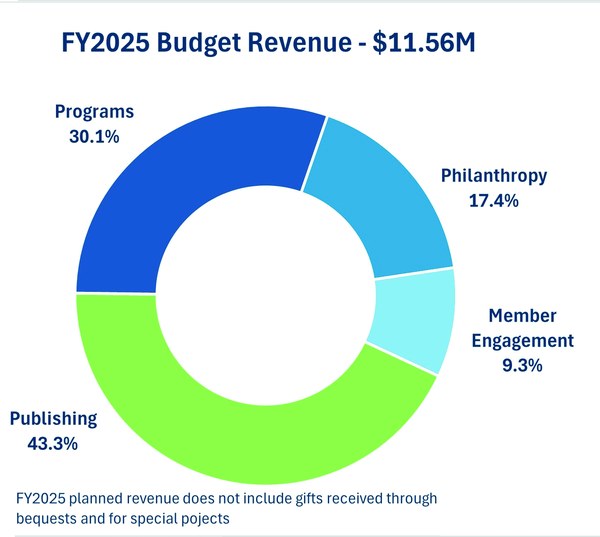 Figure 1a.
Figure 1a.
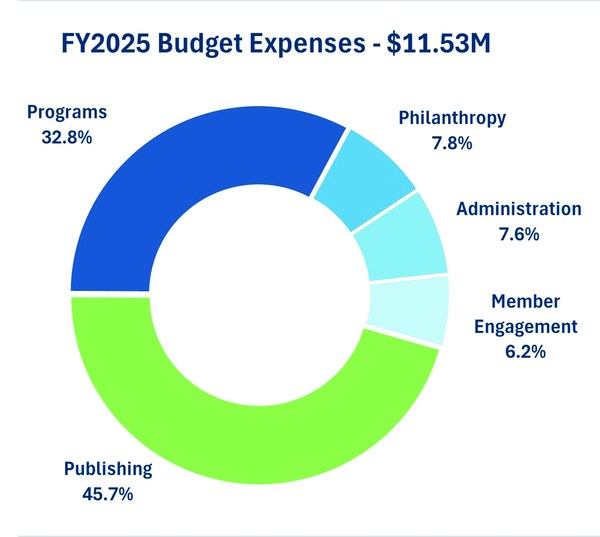 Figure 1b.
Figure 1b.
Financial transparency
Figures 1a and 1b provide a glimpse into the diversity of funding and spending areas in our FY2025 budget. It’s worth noting that categories such as ‘Programs’ and ‘Membership’ span multiple components, including the activities of staff and volunteers alike. While our budget is $11.53M, our margin (revenue less expenses) is only $30K. This speaks to the level of complexity required in unifying and aligning our diverse programs with our nonprofit structure, and the role philanthropy can play to help us meet our objectives.
As a nonprofit dedicated to serving the community, we are committed to openly sharing how funds are raised, allocated, and spent. We do this by providing clear and accessible financial information, such as annual budgets, monthly reporting to staff and volunteers, audited financial statements, and tax returns. This transparency strengthens our relationship with supporters and reinforces our mission-driven approach, ensuring that every dollar contributes meaningfully to the impact we strive to make.
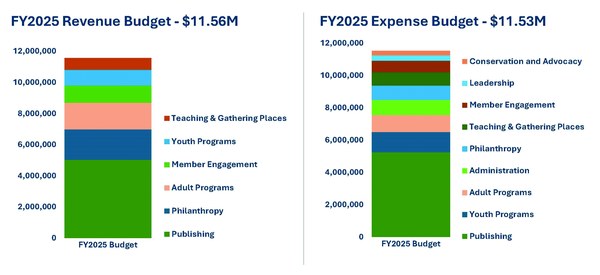 Figure 2.
Figure 2.
Figure 2 shows a side-by-side stacking of our revenue and expenses, revealing an essentially break-even budget. This figure also blends earned and contributed revenue (both restricted and unrestricted). These funding sources meet today's needs, highlighted on the expense side, and support our ability to operate and grow into the future. While figure 2 presents a more holistic picture, it does not show the full breadth of what we do.
The value of unrestricted giving
While both restricted and unrestricted funding are vital to accomplishing the work of The Mountaineers, one of the strongest tools for meeting financial needs is unrestricted giving. While project-specific and program-specific donations are essential, unrestricted funds give us the flexibility to respond to urgent needs, invest in long-term growth, and strengthen core operations. By giving without restrictions, you’re not just supporting a single initiative, you’re empowering the entire organization to thrive.
Unrestricted giving also makes the work of support staff possible. Our support staff plays a key role in advancing the success of our impact programs, from coordinating logistics to strategic planning to supporting members and volunteers. Staff helps recruit, train, and recognize volunteers, ensuring they feel valued and prepared; maintains the tools, systems, and spaces that make courses and events possible; and stewards the resources that keep programs sustainable. By handling these essential tasks, volunteers are empowered to focus on what they do best: teaching skills, leading trips, and building community.
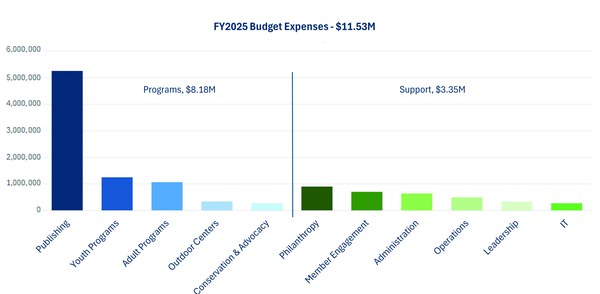 Figure 3a.
Figure 3a.
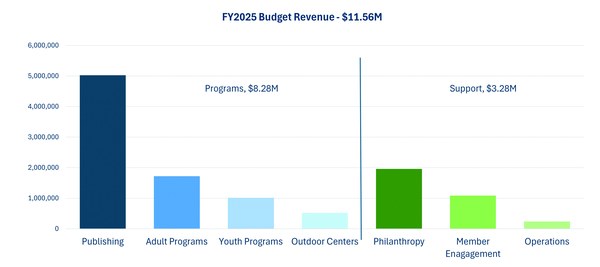 Figure 3b.
Figure 3b.
Figure 3a provides more detail behind our FY2025 operating budget. Starting with expenses, the chart shows how resources were allocated as we prepared for what is now our current year. Of our $11.53M budget, $8.18M was direct program spending while $3.35M was for staff support functions. This figure is intended to show costs in each area and does not reflect allocations made for the Statement of Functional Expenses as it appears in our audited financial statements and tax return/Form 990.
Figure 3b is a companion to the expense chart, showcasing revenue generated by each area. You’ll notice the staff support functions also bring in revenue to support the overall organization. Philanthropy represents contributed revenue (donations and grants) while the rest are earned by the specific activities of that function. While the ratio between the sections is quite similar to expenses, it’s important to note that funds cross between the two groups. A prime example is that while restricted contributions are reflected in philanthropy, they are utilized for programmatic activities such as scholarships, publishing, and conservation & advocacy.
Figures 3a and 3b further highlight the complex nature of our organization and illustrate the importance of flexible, unrestricted funding which provides the ability to direct resources where they are needed most, which is key for a complex organization, with a complex structure operating in a dynamic world.
Next steps
Our focus is on continuous improvement, and we’ll look to use this, and other Impact Giving articles, as a foundation on which to increase transparency and build deeper understanding. If you’d like to learn more, please join us for our State of the Organization virtual event on June 10, 2025.
To learn about our strategic plan, visit mountaineers.org/AWP-strategic-plan. To learn about finances at The Mountaineers, visit mountaineers.org/financial.
This article originally appeared in our summer 2025 issue of Mountaineer magazine. To view the original article in magazine form and read more stories from our publication, visit our magazine archive.
 Richard Heine
Richard Heine